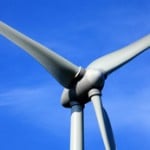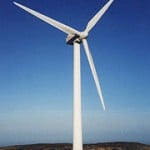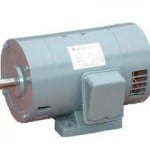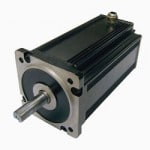
Wind turbine blade design is a major factor in turbine propulsion, efficiency, noise, and control. The aerodynamic design of a wind turbine blade includes parameters such as blade shape, quantity, aerofoil selection and optimal attack angle in order to extract the most energy from the wind. The rotor blades of modern horizontal axis wind turbines closely resemble the look and shape of an aeroplanes propeller as there are similarities in their operation. The relationship between a rotor blades rotational velocity and relative wind speed, called its tip speed ratio is the main blade design parameter to consider as well as the number of blades, chord widths, and aerofoil lift

Verical wind turbines are a relatively new concept in the design of wind turbines. Different vertical axis machines are being designed and developed such as the helical types which can catch the wind from all directions for use in urban environments where their small size and high power output are more suited to home use. Vertical axis wind turbines are also considered safer due to their lower vertical height, rotational speeds, and less moving mechanical components. VAWT designs have their electrical generators positioned closer to the ground for easily access and maintanence. The Darrieus and the Savonius vertical axis types are emerging as the most popular

Induction generators are electrical machines used in wind turbine and hydro turbine applications to generate electrical energy. Wind turbines operate over a wide range of wind speeds so any electrical generator attached to the turbines blades must also be able to operate at a variable rotational speed. Induction machines are asynchronous generators meaning that when it is driven or rotated at a higher speed than its synchronous speed, that is the rotational speed determined by the frequency of the supply, its torque will be negative so starts acting as a generator rather than a motor. Then operating an induction machine as a generator it is necessary to turn the machines rotor faster than the synchronous speed

Wind turbine rotor blades are the main component of any wind power system because without them the rotor will not rotate, so the deign and shape of the blades used for propulsion affects the maximum possible efficiency of the rotor. Over the centuries many types of design of rotor blades have emerged from the wood and cloth designs of windmills to the high torque aerodynamic aerofoil designs of today. Aerofoil three bladed horizontal axis wind turbine designs are now the norm for electricity generation due mainly to its ability to survive and operate under varying wind conditions. The optimum efficient shape of a turbine rotor blade is complex as efficiency, control, noise and aesthetics allplay a role in its design

Induction generators are squirrel caged machines responsible for transforming the kinetic energy of the wind into electrical energy. Three-phase induction machines have three electrical windings embedded into its stator so are well suited for wind power and even hydroelectric power generation. Induction machines, also known as asynchronous machines, rotate above synchronous speed when used as an electrical generator producing 3-phase AC electricity. As an induction generator can be synchronised directly with the main utility grid supply, it produces electricity at the same frequency and voltage.

Synchronous generators require an external DC power supply to be applied to the main rotor windings by means of slip-rings and carbon brushes in order to produce a constant magnetic field basically making the main rotating part (the rotor) of a synchronous machine into a large electromagnet. The rotor is rotated by the external wind turbine blades connected to it creating a rotating magnetic field within the generators body. Electrical copper windings are incased into the stationary part (the stator) of the synchronous generators body and are the main windings where the voltage is induced. So by varying the amount of rotor field current, it is possible to vary the staors output voltage.

Permanent magnet DC generators, or PMDC machines, can be used as either conventional motors or as DC wind turbine generators as constructionally there is no basic difference between the two. In fact, the same PMDC machine may be driven electrically as a motor to move a mechanical load, or it may be driven mechanically as a simple generator to generate an output voltage. This then makes the permanent magnet DC generator (PMDC generator) ideal for use as a simple wind turbine generator. The two basic connections for a permanent magnet DC machine are shunt wound and series wound, with each type of DC generator having its own set of advantages and disadvantages.

Wind turbine generators for wind power applications can vary from a small DC voltage dynamo to large AC mains rated synchronous machines. The type of electrical machine used to generate the electrical energy depends alot on the size, complexity and dynamics of the wind power as small machines can operate suscessfully in small-scale home or garden based generating applications with steady state wind conditions, whereas larger machines may be required to supply several households in windy mountainous areas or offshore conditions were the voltage and frequency of generated electricity may need to be synchronised before it can be transferred and used by the grid.

Wind turbine design for wind power applications involves understanding the basic concepts about aerodynamics, mechanics, structural theory as well as the flight mechanics of fixed-wing and rotary-wing blades. People think that the design of a wind turbine is straightforward, erect a pole or structure, add a generator to the top, and connect some blades to it. But the cost of generating electrical power from wind energy is linked to its design, efficiency and reliability of the turbine.

Wind energy is the movement of the air through the earths lower atmosphere varying from zero velocity to high gusts so you would think it would be impossible to exploit this resource. But the world has an inexhaustible supply of free wind energy as every corner of the planet receives the effects of the moving wind at some time during the day. Also, due to annual variations from summer to winter, or geographic locations from flat desert lands to high mountain ranges, different parts of the planet receives more of the winds energy than others making it an important renewable energy source.